Anna Grassellino, senior scientist at Fermi National Accelerator Laboratory and the director of the Superconducting Quantum Materials and Systems Center, was awarded the prestigious Marisa Bellisario Award on June 18, 2024.
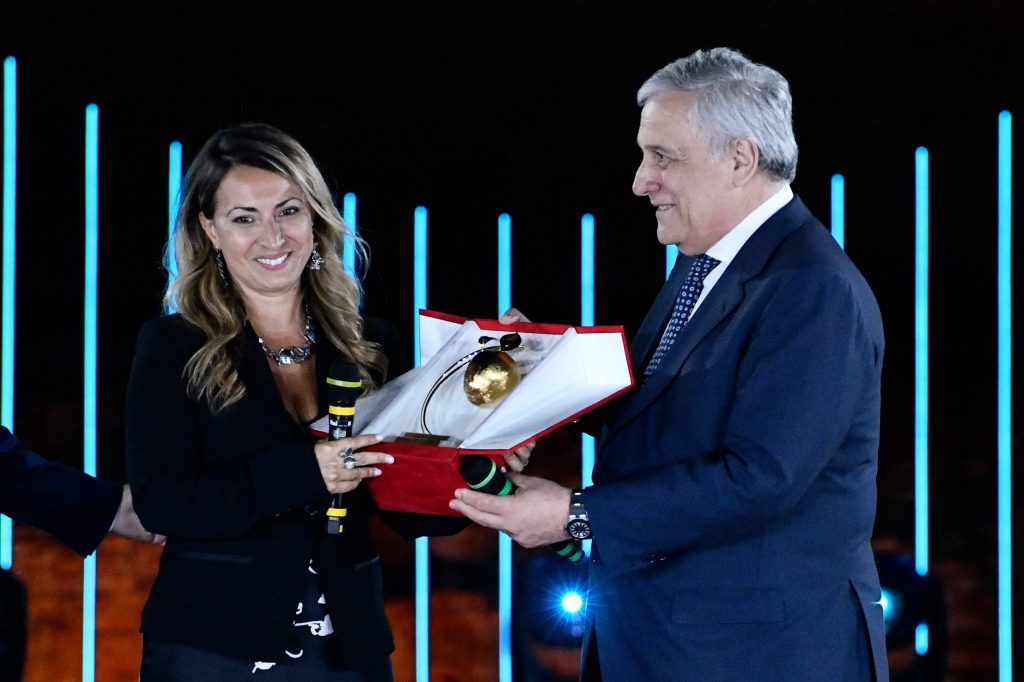
Anna Grassellino receives the Marisa Bellisario Award, “Women who make the difference,” from Italian Minister of Foreign Affairs Antonio Tajani. Credit: Marisa Bellisario Foundation
Grassellino, originally from Marsala, Italy, has made significant contributions to the field of superconducting radiofrequency (SRF) technology, a critical technology in modern particle accelerators and quantum information science. She has led groundbreaking work in increasing the efficiency of SRF cavities and their use in several novel experiments, ranging from quantum computing to searching for new particles, which is at the core of the SQMS Center mission.
“I’m so honored to be recognized with this award among extraordinary women who have distinguished themselves and have made important contributions in many fields from science to economy to entrepreneurship to sports and so much more,” said Grassellino. “I hope to serve as a role model for young women who aspire to have a career in STEM.”
The 10 award recipients met with Italian President Sergio Mattarella and Bellisario Foundation President Lella Golfo at Palazzo Quirinale. Later that evening, a formal ceremony was held in Rome’s historic Colosseum where Grassellino received the award from Italian Minister of Foreign Affairs Antonio Tajani.
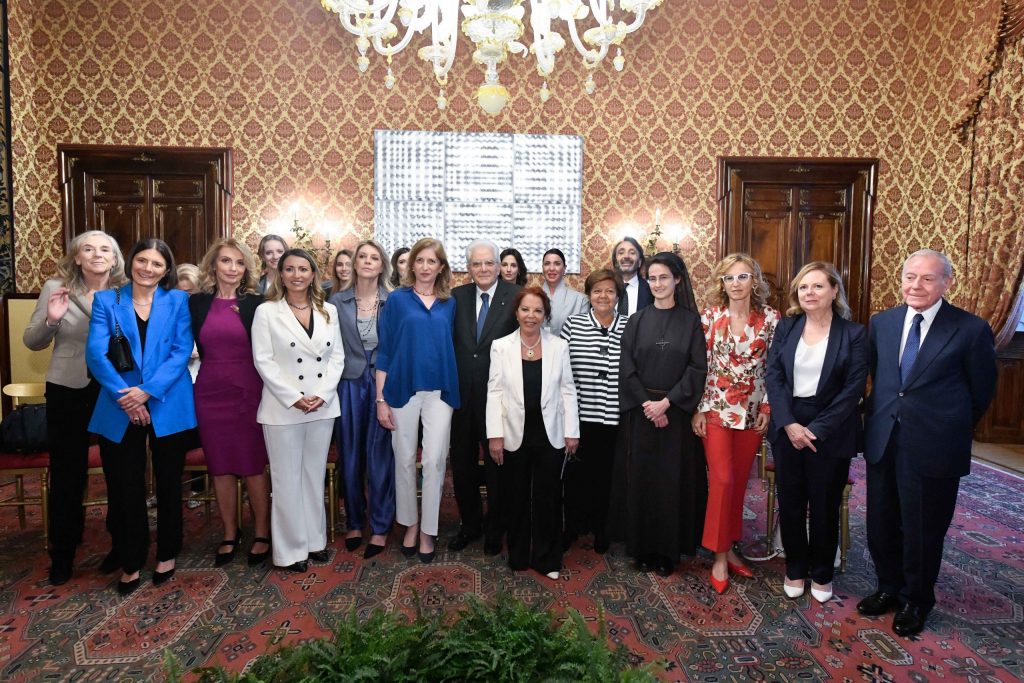
The recipients of the Marisa Bellisario Award gather for a photo at a meeting at Palazzo Quirinale with Italian President Sergio Mattarella. Credit: Marisa Bellisario Foundation
The Bellisario award recognized Grassellino’s outstanding achievements and her influence as a role model for women in science and technology. The award citation read by Minister Tajani stated: “Anna Grassellino receives the Bellisario Award for the extraordinary talent, determination and courage that have earned her the international leadership in research, in technologies that will open new scientific horizons. She is an ambassador of the Italian genius in the world and source of inspiration for all girls who aspire to have a STEM career.”
The Marisa Bellisario Award is one of Italy’s most prestigious honors dedicated to women who have excelled in various professional, social, cultural and scientific fields. The award was established in 1989 in memory of Marisa Bellisario, one of Italy’s first successful female managers. It celebrates female excellence and promotes the role of women in the workplace and society.
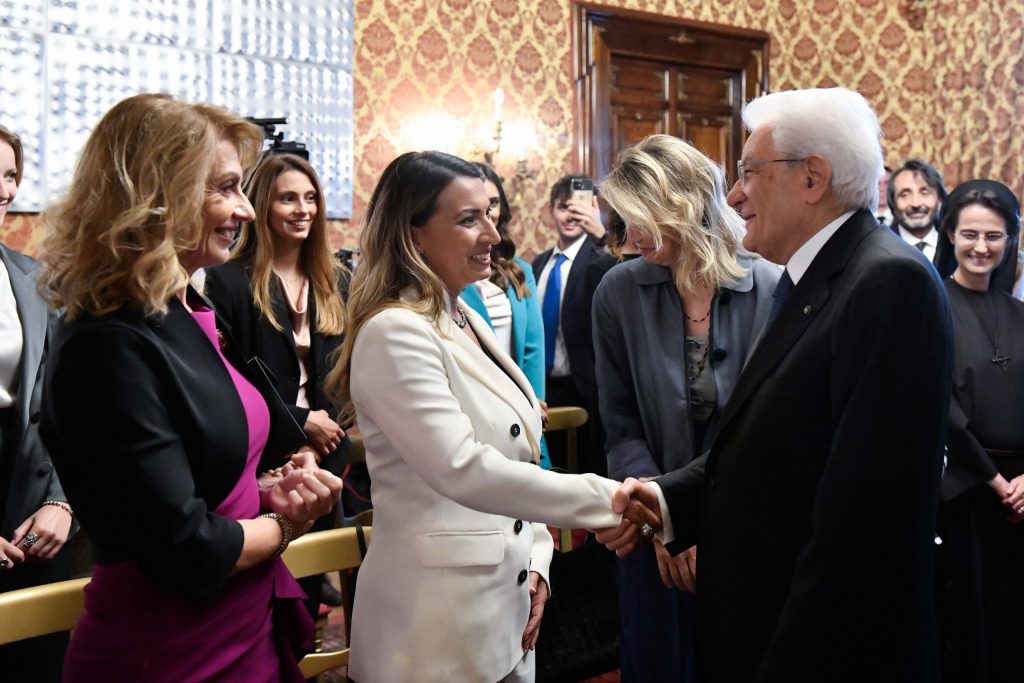
Italian President Sergio Mattarella congratulates Anna Grassellino for receiving the international award from the Marisa Bellisario Foundation. Credit: Marisa Bellisario Foundation
“This is an impressive award and I extend my most sincere congratulations to Anna for receiving this recognition,” said Lia Merminga, Fermilab Director. “Anna is a wonderful ambassador for the mission of Fermilab. The lab community and I are very proud of her.”
More information about the Marisa Bellisario Foundation and its mission can be found here.
Fermi National Accelerator Laboratory has announced two new initiatives to foster innovation and growth in the engineering and technical communities of the lab. The Office of High Energy Physics, within the Department of Energy’s Office of Science, has granted Fermilab, a DOE laboratory, $2 million to fund these two initiatives over the next five years.
Chief Engineer Mayling Wong-Squires states, “The lab is grateful for the support from the Office of High Energy Physics with the recognition of creative ways to develop the engineering and technical staff.”
The first initiative is a pilot apprenticeship program called Technician Education for Careers out of High School. TECHS will strengthen recruitment of the laboratory’s technicians who are critically important to the lab’s operations and future projects. The apprenticeship will be a talent incubator to nurture future lab technicians by offering summer apprenticeships to local high school students who will be trained on basic electrical and mechanical skills while introducing them to the array of careers at Fermilab.
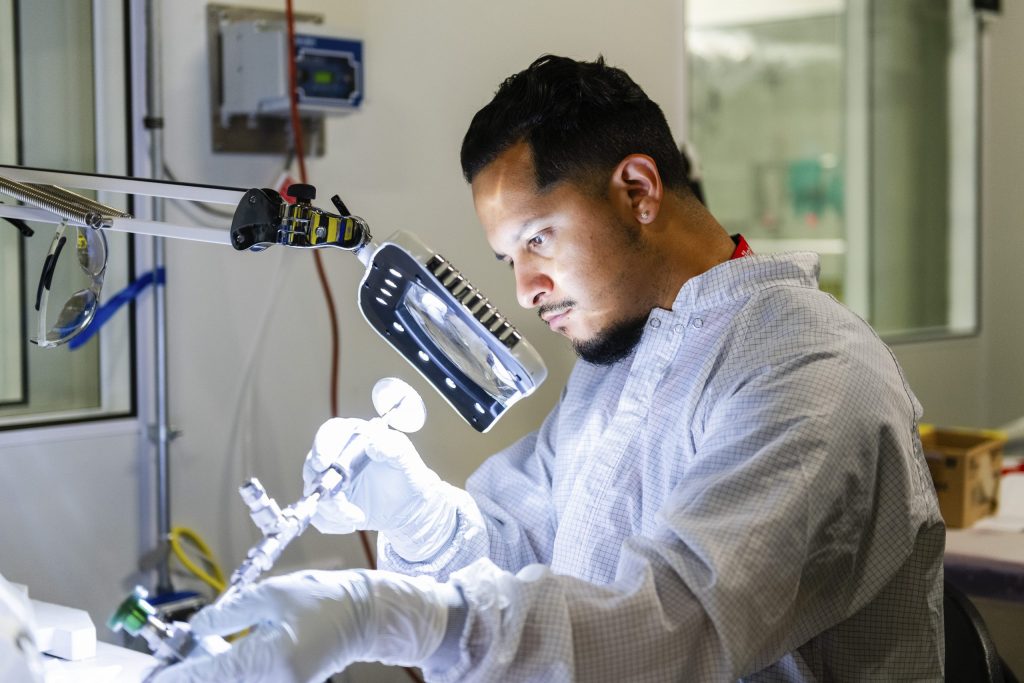
Fermilab technician Marino Alvarado works on components for a Proton Improvement Plan-II cryomodule. Photo: Ryan Postel, Fermilab
Students will work at Fermilab for 10 weeks for two consecutive summers. They will be mentored by lab technicians and program teachers on projects that support Fermilab’s scientific mission. Upon completion of the program, students will be qualified and encouraged to apply for entry-level technician positions upon graduation from high school.
Spokespeople for the program will begin reaching out to area schools in the upcoming school year with applications opening in late 2024.
The second initiative is the Fermilab Innovative Design Engineering to Accelerate Solutions program, in which the lab’s engineers are encouraged to pursue new ideas and designs, simple or complex, that can lead to innovative solutions in areas of research and development. IDEAS will support various endeavors that include small-scale prototypes using microgrants, ideas for patents or copyrights, and proposals for the DOE Early Career Research Program.
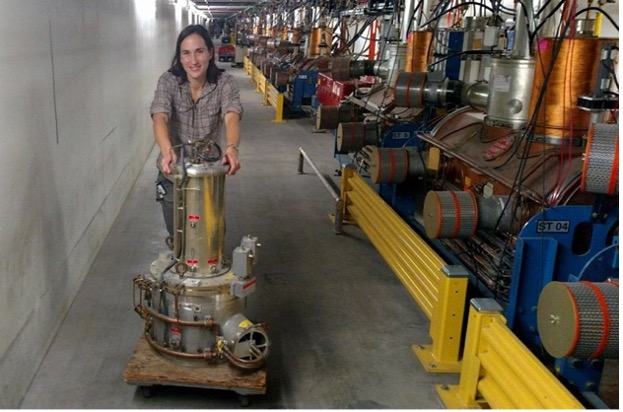
Rachel Pfaff has been a technician in the radio frequency department and enjoys the diverse work in her role at Fermilab. Photo: Rachel Pfaff, Fermilab
Lab Director Lia Merminga said, “This timely initiative strengthens technology innovation, a cornerstone of our mission at Fermilab, and enables our engineers to expand the lab’s work in its core capabilities, especially the newest ones: Mechanical Engineering and Systems Engineering.”
More information about each program can be found at the TECHS and IDEAS websites.
Fermi National Accelerator Laboratory is supported by the Office of Science of the U.S. Department of Energy. The Office of Science is the single largest supporter of basic research in the physical sciences in the United States and is working to address some of the most pressing challenges of our time. For more information, please visit science.energy.gov.
Using an instrument on the 4.1-meter Southern Astrophysical Research Telescope, researchers obtained the first astronomical spectrum using skipper charge-coupled devices (CCDs).
The results were presented on June 16 at the Society of Photo-Optical Instrumentation Engineers Astronomical Telescopes + Instrumentation meeting in Japan by Edgar Marrufo Villalpando, a physics PhD candidate at the University of Chicago and a Fermilab DOE Graduate Instrumentation Research Award Fellow.
“This is a major milestone for skipper-CCD technology,” said Alex Drlica-Wagner, a cosmologist at the U.S. Department of Energy’s Fermi National Accelerator Laboratory who led the project. “It helps to retire the perceived risks for using this technology in the future, which is vitally important for future DOE cosmology projects.”
This is an important achievement for a project conceived and initiated through the Laboratory Directed Research and Development program at Fermilab in collaboration with NSF’s NOIRLab detector group. LDRD is a national program sponsored by the DOE that allows national laboratories to internally fund research and development projects that explore new ideas or concepts.
CCDs were invented in the United States in 1969, and forty years later scientists were awarded the Nobel Prize in Physics for their achievement. The devices are two-dimensional arrays of light-sensitive pixels that convert incoming photons into electrons. Conventional CCDs are the image sensors first used in digital cameras, and they remain the standard for many scientific imaging applications, such as astronomy, though their precision is limited by electronic noise.
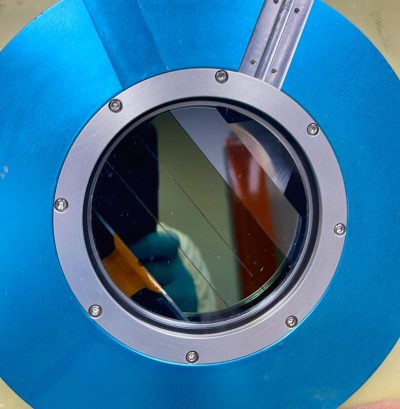
The four skipper CCDs mounted inside a cryogenic vacuum vessel in preparation for on-sky observations. Credit: Edgar Marrufo Villalpando/AstroSkipper Collaboration
Cosmologists seek to understand the mysterious natures of dark matter and dark energy by studying the distributions of stars and galaxies. To do this, they need advanced technology that can see fainter, more distant astronomical objects with as little noise as possible.
Existing CCD technology can make these measurements but take a long time or are less efficient. So, astrophysicists must either increase the signal — i.e., by investing more time on the world’s largest telescopes — or decrease the electronic noise.
Skipper CCDs were introduced in 1990 to reduce electronic noise to levels that allow the measurement of individual photons. They do this by taking multiple measurements of interesting pixels and skipping the rest. This strategy enables skipper CCDs to increase the precision of measurements in interesting regions of the image while reducing total readout time.
In 2017, scientists pioneered the use of skipper CCDs for dark matter experiments such as SENSEI and OSCURA, but this year’s presentation showed the first time the technology was used to observe the night sky and collect astronomical data.
On March 31 and April 9, the researchers used skipper CCDs in the SOAR Integral Field Spectrograph to collect astronomical spectra from a galaxy cluster, two distant quasars, a galaxy with bright emission lines, and a star that is potentially associated with a dark-matter-dominated ultra-faint galaxy. In a first for astrophysical CCD observations, they achieved sub-electron readout noise and counted individual photons at optical wavelengths.
“What’s incredible is that these photons traveled to our detectors from objects billions of light-years away, and we could measure each one individually,” said Marrufo Villalpando.
Researchers are analyzing data from these first observations, and the next scheduled run for the skipper-CCD instrument on the SOAR Telescope is in July 2024.
“Many decades have passed since the skipper was born, so I was surprised to see the technology come to life again,” said Jim Janesick, inventor of the skipper CCD and a distinguished engineer at SRI International, a research institute based in California. “The noise results are amazing! I fell off my seat when I saw the very clean sub-electron noise data.”
With the first successful demonstration of skipper-CCD technology for astrophysics, scientists are already working to improve it. The next generation of skipper CCDs, developed by Fermilab and Lawrence Berkeley National Laboratory, is 16 times faster than current devices. These new devices will greatly reduce readout time, and researchers have already begun testing them in the laboratory.
The emission of ionizing photons from a distant quasar emitted about 12 billion years ago are hidden in the electronic noise of conventional detectors, but they become visible with the skipper CCD’s ability to count individual photons. Credit: Edgar Marrufo Villalpando/AstroSkipper Collaboration
The next generation of skipper CCDs has been identified for use in future DOE cosmology efforts, such as the spectroscopic experiments DESI-II and Spec-S5, recommended by the recent U.S. particle physics planning process. In addition, NASA is considering skipper CCDs for the forthcoming Habitable Worlds Observatory that will attempt to detect earth-like planets around sun-like stars.
“I’m looking forward to seeing where these detectors might end up,” said Marrufo Villalpando, who joined the program in 2019. “People are using them for amazing things all over; their utility ranges from particle physics to cosmology. It’s a very versatile and useful technology.”
The project was a close collaboration between physicists, astronomers and engineers at Fermilab, UChicago, the National Science Foundation’s NOIRLab, DOE’s Lawrence Berkeley National Laboratory, and the National Astrophysical Laboratory of Brazil.
Fermi National Accelerator Laboratory is supported by the Office of Science of the U.S. Department of Energy. The Office of Science is the single largest supporter of basic research in the physical sciences in the United States and is working to address some of the most pressing challenges of our time. For more information, please visit science.energy.gov.
The international NOvA collaboration presented new results at the Neutrino 2024 conference in Milan, Italy, on June 17. The collaboration doubled their neutrino data since their previous release four years ago, including adding a new low-energy sample of electron neutrinos. The new results are consistent with previous NOvA results, but with improved precision. The data favor the “normal” ordering of neutrino masses more strongly than before, but ambiguity remains around the neutrino’s oscillation properties.
The latest NOvA data provide a very precise measurement of the bigger splitting between the squared neutrino masses and slightly favor the normal mass ordering. That precision on the mass splitting means that, when coupled with data from other experiments performed at nuclear reactors, the data favor the normal ordering at almost 7:1 odds. This suggests that neutrinos adhere to the normal ordering, but physicists have not met the high threshold of certainty required to declare a discovery.

Probability distributions for the value of the larger neutrino mass squared splitting from NOvA data when antineutrino measurements at nuclear reactors are included. The normal (blue) mass ordering is preferred over the inverted (red) one by a factor of 7:1. Credit: NOvA Collaboration
NOvA, short for NuMI Off-axis νe Appearance, is an experiment managed by the U.S. Department of Energy’s Fermi National Accelerator Laboratory, located outside of Chicago. Fermilab sends a beam of neutrinos 500 miles north to a 14,000-ton detector in Ash River, Minnesota. By measuring the neutrinos and their antimatter partners, antineutrinos, in both locations, physicists can study how these particles change their type as they travel, a phenomenon known as neutrino oscillation.
NOvA aims to learn more about the ordering of neutrino masses. Physicists know that there are three types of neutrinos with different masses, but they don’t know the absolute mass, nor which is heaviest. Theoretical models predict two possible mass orderings, normal or inverted. In the normal ordering, there are two light neutrinos and one heavier neutrino; in inverted, there is one light neutrino and two heavier ones.
“Getting additional information from reactor experiments enhances our knowledge of the mass ordering and gets us close to exciting territory,” said Erika Catano-Mur, a postdoctoral research associate at William & Mary and co-convener of the analysis. “We almost have an answer to one of those big questions that we have in neutrino physics. But we’re not there yet.”
The solution to neutrino oscillation remains ambiguous in the new results. Physicists don’t currently have enough data to disentangle two effects on the oscillation: mass ordering and a property called charge parity violation. The collaboration observed a moderate amount of oscillation that could be explained in either mass ordering scenario with different amounts of CP violation, so they cannot tease apart the mass ordering and CP violation. However, the physicists were able to rule out specific combinations of the two properties.

An electron neutrino scattering event from the latest NOvA dataset. The brighter the yellow pixels, the more energy that was deposited. Physicists know this is a neutrino because it occurs in time with the beam pulse, “points” back to Fermilab, and occurs far away from the edges of the detector, meaning whatever initiated the activity had to travel through a lot of matter without leaving a trace. The electron in the final state is initially track-like, but then develops into an electromagnetic cascade. Credit: NOvA Collaboration
“It really takes more than one measurement for us to learn everything we need to know,” said Jeremy Wolcott, a postdoctoral fellow at Tufts University, one of NOvA’s analysis coordinators and the speaker at the conference.
“NOvA is an important player in this because there are unique aspects to all of the various experiments that are trying to measure the same parameters,” said Wolcott. “We’re starting to see a picture come together, but it’s murky. Having different measurements that all work together is really important.”
The NOvA experiment started taking data in 2014 and will continue running through early 2027, during which time the collaboration hopes to double their antineutrino dataset. They also continue to implement analysis improvements to maximize the sensitivity of the experiment.
Their efforts are also paving the way for future experiments that will seek to contribute even more to solving the mysteries around neutrino properties.
“We want to make the most that we can out of the data,” said Catano-Mur. “What we learn — not only from the results themselves, but in the process, what we’re learning about the analysis methods — is going to be useful for the next generation of experiments that right now are under construction.”
Still, NOvA has the potential to reveal more about the elusive neutrino. “This result is an important reminder that the current generation of experiments, including NOvA, continues to collect valuable data and produce physics insights,” said Zoya Vallari, postdoctoral researcher at CalTech and co-convener of the analysis. “They are our best shot at a discovery right now.”

The NOvA collaboration at their February 2024 meeting at the IIT Wheaton campus. Credit: Yagmur Torun
The NOvA collaboration is made up of more than 200 scientists from 50 institutions in eight countries. With the additional data and further analysis improvements, NOvA will bring physicists closer to understanding the identity-changing behavior of neutrinos.
Fermi National Accelerator Laboratory is supported by the Office of Science of the U.S. Department of Energy. The Office of Science is the single largest supporter of basic research in the physical sciences in the United States and is working to address some of the most pressing challenges of our time. For more information, visit science.energy.gov.
A hundred meters underground at Fermi National Accelerator Laboratory is a new quantum sensor and computing research center named the Quantum Underground Instrumentation Experimental Testbed, or QUIET. Fermilab recently opened the doors to the underground lab, which will allow scientists to study the performance of qubits isolated from cosmic radiation.
As one of the first dedicated underground Quantum Information Science facilities in the U.S, QUIET will support research and development of QIS applications. While there are many unique aspects to QUIET, finding a space far enough underground and large enough to house such a facility was difficult but a good match for existing infrastructure at Fermilab.

Fermilab celebrated the opening of the newest laboratory, the QUIET lab located a hundred meters underground. Pictured from left to right are:
Northwestern University Associate Vice President of Research, Enectalí Figueroa-Feliciano, Fermilab Associate Laboratory Director for Emerging Technologies, Panagiotis Spentzouris, Fermilab scientist Dan Baxter, Fermilab Director, Lia Merminga, QSC Director Travis Humble and Fermilab Scientist, Aaron Chou. Photo: Dan Svoboda, Fermilab
“Fermilab’s previous investment in building accelerators makes it the ideal location for a facility like QUIET,” said Fermilab scientist Dan Baxter, who leads the project. “Now, scientists will have the opportunity to use this underground space for even more advanced science.”
The new state-of-the-art lab is 250 square feet with an antechamber prep room for material cleaning and gowning before entering the laboratory. The entire facility is set up with cleanliness in mind to minimize background sources that interfere with devices. It has a dilution refrigerator, which is necessary for the deployment of superconducting qubits at 10mK temperatures. Radio frequency electronics, which superconducting qubits use to control and read out their quantum states, are currently being set up.
The primary goal of QUIET is to understand the difference between the impact of gamma rays, X-rays, muons and beta particles on superconducting qubits. Superconducting qubits used in quantum computing are very susceptible to interactions with their environment, including radiation. QUIET will allow scientists to study the performance of qubits isolated from cosmic radiation.

The Radiation Impact on Superconducting Qubits workshop was held at Fermilab in conjunction with the QUIET lab opening. It is the first meeting bringing together the broader quantum information science and particle physics communities to assess the effects of radiation and cosmic rays on superconducting solid-state qubits. Photo: Dan Svoboda, Fermilab
“We need to learn how to protect qubits from the effects of cosmic rays and energetic particles for quantum computing applications. At the same time, we must intricately understand how qubits respond to these effects in order to optimize using qubits as sensors. QUIET is designed to do exactly that, and we expect it to have a major impact as we move forward with these technologies,” said Panagiotis Spentzouris, associate laboratory director for Emerging Technologies at Fermilab.
QUIET is one of two Quantum Science Center companion test facilities at Fermilab. The QSC, led by Oak Ridge National Laboratory, is one of five U.S. Department of Energy National Quantum Information Science Research Centers established to support the National Quantum Initiative in the U.S. and Fermilab is a primary founding member of the QSC.
The facility was constructed as part of the National Quantum Initiative. The underground space was originally excavated by Fermilab for its neutrino experiments. QUIET’s counterpart lab called LOUD, which resides above ground, has been operating for over a year. QUIET uses the same models of dilution refrigeration and electronics as LOUD but with additional shielding from radiation.
“This was quite an achievement to pull off and required a significant amount of work behind the scenes,” said QSC Director Travis Humble. “Together, QUIET and LOUD will allow for controlled experiments with quantum sensors to make direct comparisons between an environment with significantly reduced cosmic ray interference and the ambient environment on Earth’s surface.”
QUIET and LOUD are funded through the QSC.
Fermi National Accelerator Laboratory is supported by the Office of Science of the U.S. Department of Energy. The Office of Science is the single largest supporter of basic research in the physical sciences in the United States and is working to address some of the most pressing challenges of our time. For more information, please visit science.energy.gov.

